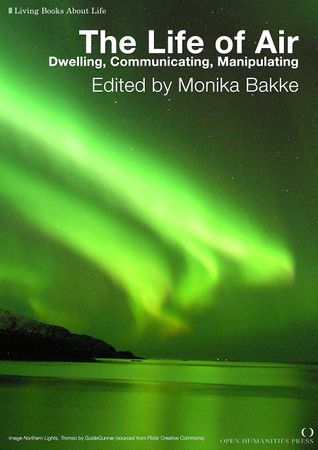The Life of Air: Difference between revisions
No edit summary |
No edit summary |
||
| Line 50: | Line 50: | ||
== A 'Frozen' PDF Version of this Living Book == | == A 'Frozen' PDF Version of this Living Book == | ||
; [http://livingbooksaboutlife.org/pdfs/bookarchive/LifeofAir.pdf Download a 'frozen' PDF version of this book | ; [http://livingbooksaboutlife.org/pdfs/bookarchive/LifeofAir.pdf Download a 'frozen' PDF version of this book as it appeared on 7th October 2011] | ||
Revision as of 09:04, 11 October 2011

Dwelling, Communicating, Manipulating
edited by Monika Bakke
Introduction: The Multispecies Use of Air
‘It’s alive!’ we could certainly exclaim if confronted with a microscopic view of air. As aerobiologists observe, ‘[h]undreds of thousands of individual microbial cells can exist in a cubic metre of air, representing perhaps hundreds of unique taxa’ (Womack et al., 2010: 3645). But what deserves special attention here is not only that air is full of life but also, apart from being a mean of transport and communication, air is a habitat in its own right. The zoe of air comes in abundance and we – breathing organisms – are all in this together for better and for worse, dead or alive. We have finally come to realize that air is messy, being neither an empty space nor a void, but a space where species meet. And like any other life form, as Donna Haraway emphasizes, we find ourselves ‘in a knot of species coshaping one another in layers of reciprocating complexity all the way down’ (2008: 42). (more...)
Dwelling in Air
- Ann M. Womack, Brendan J. M. Bohannan, Jessica L. Green
- Biodiversity and Biogeography of the Atmosphere
- Anna A. Gorbushina, Renate Kort, Anette Schulte, David Lazarus, Bernhard Schnetger, Hans-Jürgen Brumsack, William J. Broughton, Jocelyne Favet
- Life in Darwin's Dust: Intercontinental Transport and Survival of Microbes in the Nineteenth Century
- Anders Hedenström
- Extreme Endurance Migration: What Is the Limit to Non-Stop Flight?
- Elizabeth Thomas
- Tomas Saraceno Looks to the Sky and Sees Possibilities
- Nerea Cavillo
- In the Air
- Steven Connor – Taking to the Air
Nonhuman Volatile Communication
- Frederick R. Adler
- Plant Signalling: The Opportunities and Dangers of Chemical Communication
- Geraldine A. Wright, Florian P. Schiestl
- The Evolution of Floral Scent: The Influence of Olfactory Learning by Insect Pollinators on the Honest Signalling of Floral Rewards
- Michael R. Whitehead, Rod Peakall
- Integrating Floral Scent, Pollination Ecology and Population Genetics
- Corinna Thom, David C. Gilley, Judith Hooper, Harald E. Esch
- The Scent of the Waggle Dance
Anthropology of Scents
- Gordon M. Shepherd
- The Human Sense of Smell: Are We Better Than We Think?
- Charles J. Wysocki, George Preti
- Facts, Fallacies, Fears, and Frustrations with Human Pheromones
- Susana Camara Leret
- Smellscapes: The Loss of Smell in a Visual Culture
- Usman Haque
- Scents of Space
- Oswaldo Maciá, Jenny Marketou, Chrysanne Stathacos, Clara Ursitti
- Odor Limits
Inspiration-Expiration
- Bogusław Buszewski, Martyna Kęsy, Tomasz Ligor, Anton Amann
- Human Exhaled Air Analytics: Biomarkers of Diseases
- Sabrina Raaf
- Breath I: Pleasure
Breath Cultures
- Jarosław Kozakiewicz
- Oxygen Towers
- Tomas Saraceno
- Poetic Cosmos of the Breath
- Ruud Kaulingfreks , René Ten Bos
- Learning to Fly: Inspiration and Togetherness
- M. J. Parkes
- Breath-holding and Its Breakpoint
Airborne Anxieties
- Simon Luechinger
- Valuing Air Quality Using the Life Satisfaction Approach Valuing Air Quality Using the Life Satisfaction Approach
- G. Liccardi, A. Custovic, M. Cazzola, M. Russo, M. D'Amato, G. D'Amato
- Avoidance of Allergens and Air Pollutants in Respiratory Allergy
- Lisa Fong Poh Ng ; The Virus That Changed My World
- How Flu Viruses Attack
- What You Should Know About Biological Warfare
- How to Survive- Biological or Chemical Attack
- Critical Art Ensemble
- Bodies of Fear in a World of Threat
- Beatriz da Costa
- Pigeonblog
